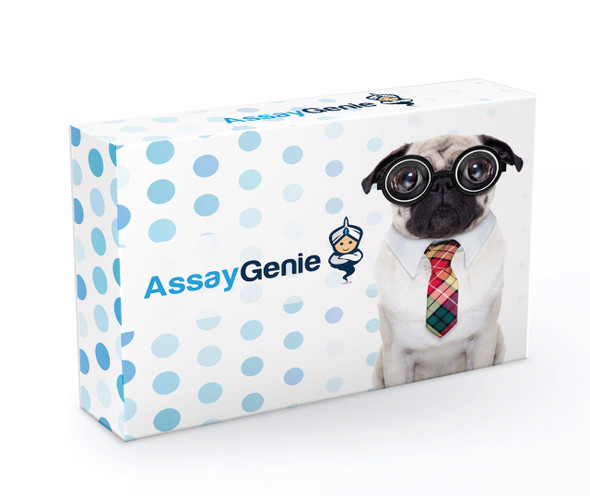Mouse FLT3(Receptor-type tyrosine-protein kinase FLT3) ELISA Kit
- SKU:
- MOFI01254
- Product Type:
- ELISA Kit
- Size:
- 96 Assays
- Uniprot:
- Q00342
- Sensitivity:
- 46.875pg/ml
- Range:
- 78.125-5000pg/ml
- ELISA Type:
- Sandwich
- Synonyms:
- Flt3, FMS Like Tyrosine Kinase 3, CD135, Flk-2, STK-1, CD135, CD135 antigen, fetal liver kinase 2, FL cytokine receptor, FLK2, FLT-3, FLT3 receptor tyrosine kinase, Fms-like tyrosine kinase 3, fms-related tyrosine kinase 3, growth factor receptor tyr
- Reactivity:
- Mouse
Description
Mouse FLT3 (Receptor-type tyrosine-protein kinase FLT3) ELISA Kit
The Mouse FLT3 Receptor (Type III Pro-Flt3) ELISA Kit is a reliable and accurate tool for the quantitative detection of FLT3 receptor levels in mouse samples including serum, plasma, and cell culture supernatants. With its high sensitivity and specificity, this kit ensures precise and consistent results, making it perfect for various research applications.The FLT3 receptor, also known as Fms-like tyrosine kinase 3, is a crucial protein involved in the regulation of hematopoietic stem cell proliferation and differentiation. Abnormalities in FLT3 receptor signaling have been associated with leukemia and other hematological malignancies, making it a valuable biomarker for studying these diseases and developing potential targeted therapies.
This ELISA kit provides researchers with a powerful tool to accurately measure FLT3 receptor levels in mouse samples, enabling a better understanding of its role in normal and diseased conditions. By using this kit, researchers can uncover valuable insights into the biology and pathology of FLT3 receptor-related disorders.
| Product Name: | Mouse FLT3(Receptor-type tyrosine-protein kinase FLT3) ELISA Kit |
| Product Code: | MOFI01254 |
| Size: | 96 Assays |
| Alias: | Flt3, FMS Like Tyrosine Kinase 3, CD135, Flk-2, STK-1, CD135, CD135 antigen, fetal liver kinase 2, FL cytokine receptor, FLK2, FLT-3, FLT3 receptor tyrosine kinase, Fms-like tyrosine kinase 3, fms-related tyrosine kinase 3, growth factor receptor tyrosine kinase type III, Stem cell tyrosine kinase 1 |
| Detection Method: | Sandwich ELISA |
| Application: | This immunoassay kit allows for the in vitro quantitative determination of Mouse FLT3 concentrations in serum plasma and other biological fluids. |
| Sensitivity: | 46.875pg/ml |
| Range: | 78.125-5000pg/ml |
| Storage: | 4°C for 6 months |
| Note: | For Research Use Only |
| Recovery: | Matrices listed below were spiked with certain level of Mouse FLT3 and the recovery rates were calculated by comparing the measured value to the expected amount of Mouse FLT3 in samples. Not Available. |
| Linearity: | The linearity of the kit was assayed by testing samples spiked with appropriate concentration of Mouse FLT3 and their serial dilutions. The results were demonstrated by the percentage of calculated concentration to the expected. Not Available. |
| Intra Assay: | CV <8% |
| Inter Assay: | CV <10% |
| Component | Quantity | Storage |
| ELISA Microplate (Dismountable) | 8-12 strips | 4°C for 6 months |
| Lyophilized Standard | 2 | 4°C/-20°C |
| Sample/Standard Dilution Buffer | 20ml | 4°C |
| Biotin-labeled Antibody(Concentrated) | 120ul | 4°C (Protect from light) |
| Antibody Dilution Buffer | 10ml | 4°C |
| HRP-Streptavidin Conjugate(SABC) | 120ul | 4°C (Protect from light) |
| SABC Dilution Buffer | 10ml | 4°C |
| TMB Substrate | 10ml | 4°C (Protect from light) |
| Stop Solution | 10ml | 4°C |
| Wash Buffer(25X) | 30ml | 4°C |
| Plate Sealer | 5 | - |
Other materials and equipment required:
- Microplate reader with 450 nm wavelength filter
- Multichannel Pipette, Pipette, microcentrifuge tubes and disposable pipette tips
- Incubator
- Deionized or distilled water
- Absorbent paper
- Buffer resevoir
| Uniprot | Q00342 |
| UniProt Protein Function: | FLT3: a receptor tyrosine kinase of the PDGFR family that binds the FL cytokine. FLT3 -/- mice have an impaired developmental capacity of primitive hematopoietic progenitor cells of all lineages with the greatest impact on lymphopoietic precursors. Activating mutations found in one third of cases of acute myeloid leukemia (AML), as well as in acute lymphoblastic leukemia, acute promyelocytic leukemia and myelodysplastic syndrome. Inhibitors: Sutent and PKC412. |
| UniProt Protein Details: | Protein type:Oncoprotein; Protein kinase, tyrosine (receptor); Kinase, protein; Membrane protein, integral; Protein kinase, TK; EC 2.7.10.1; TK group; PDGFR family Cellular Component: cell surface; cytoplasm; cytosol; external side of plasma membrane; nucleus; plasma membrane; protein complex Molecular Function:glucocorticoid receptor binding; hematopoietin/interferon-class (D200-domain) cytokine receptor activity; phosphoinositide 3-kinase binding; protein binding; protein complex binding; protein-tyrosine kinase activity; ubiquitin protein ligase binding Biological Process: antigen processing and presentation; B cell differentiation; cytokine and chemokine mediated signaling pathway; hemopoiesis; homeostasis of number of cells within a tissue; leukocyte homeostasis; lymph node development; lymphocyte differentiation; lymphocyte proliferation; lymphoid progenitor cell differentiation; myeloid progenitor cell differentiation; negative regulation of B cell differentiation; negative regulation of cell proliferation; negative regulation of interleukin-6 production; negative regulation of tumor necrosis factor production; positive regulation of interferon-alpha production; positive regulation of interferon-gamma production; positive regulation of interleukin-12 production; positive regulation of multicellular organism growth; positive regulation of protein amino acid phosphorylation; post-embryonic development; pro-B cell differentiation; pro-T cell differentiation; protein amino acid autophosphorylation; spleen development |
| UniProt Code: | Q00342 |
| NCBI GenInfo Identifier: | 803341901 |
| NCBI Gene ID: | 14255 |
| NCBI Accession: | Q00342.2 |
| UniProt Related Accession: | Q00342 |
| Molecular Weight: | 113,496 Da |
| NCBI Full Name: | Receptor-type tyrosine-protein kinase FLT3 |
| NCBI Synonym Full Names: | FMS-like tyrosine kinase 3 |
| NCBI Official Symbol: | Flt3 |
| NCBI Official Synonym Symbols: | Flk2; Ly72; wmfl; CD135; Flk-2; Flt-3; B230315G04 |
| NCBI Protein Information: | receptor-type tyrosine-protein kinase FLT3 |
| UniProt Protein Name: | Receptor-type tyrosine-protein kinase FLT3 |
| UniProt Synonym Protein Names: | FL cytokine receptor; Fetal liver kinase 2; FLK-2; Fms-like tyrosine kinase 3; FLT-3; Tyrosine-protein kinase receptor flk-2; CD_antigen: CD135 |
| Protein Family: | Flt3 receptor-interacting lectin |
| UniProt Gene Name: | Flt3 |
| UniProt Entry Name: | FLT3_MOUSE |
*Note: Protocols are specific to each batch/lot. For the correct instructions please follow the protocol included in your kit.
| Step | Procedure |
| 1. | Set standard, test sample and control (zero) wells on the pre-coated plate respectively, and then, record their positions. It is recommended to measure each standard and sample in duplicate. Wash plate 2 times before adding standard, sample and control (zero) wells! |
| 2. | Aliquot 0.1ml standard solutions into the standard wells. |
| 3. | Add 0.1 ml of Sample / Standard dilution buffer into the control (zero) well. |
| 4. | Add 0.1 ml of properly diluted sample (Human serum, plasma, tissue homogenates and other biological fluids.) into test sample wells. |
| 5. | Seal the plate with a cover and incubate at 37 °C for 90 min. |
| 6. | Remove the cover and discard the plate content, clap the plate on the absorbent filter papers or other absorbent material. Do NOT let the wells completely dry at any time. Wash plate X2. |
| 7. | Add 0.1 ml of Biotin- detection antibody working solution into the above wells (standard, test sample & zero wells). Add the solution at the bottom of each well without touching the side wall. |
| 8. | Seal the plate with a cover and incubate at 37°C for 60 min. |
| 9. | Remove the cover, and wash plate 3 times with Wash buffer. Let wash buffer rest in wells for 1 min between each wash. |
| 10. | Add 0.1 ml of SABC working solution into each well, cover the plate and incubate at 37°C for 30 min. |
| 11. | Remove the cover and wash plate 5 times with Wash buffer, and each time let the wash buffer stay in the wells for 1-2 min. |
| 12. | Add 90 µL of TMB substrate into each well, cover the plate and incubate at 37°C in dark within 10-20 min. (Note: This incubation time is for reference use only, the optimal time should be determined by end user.) And the shades of blue can be seen in the first 3-4 wells (with most concentrated standard solutions), the other wells show no obvious color. |
| 13. | Add 50 µL of Stop solution into each well and mix thoroughly. The color changes into yellow immediately. |
| 14. | Read the O.D. absorbance at 450 nm in a microplate reader immediately after adding the stop solution. |
When carrying out an ELISA assay it is important to prepare your samples in order to achieve the best possible results. Below we have a list of procedures for the preparation of samples for different sample types.
| Sample Type | Protocol |
| Serum: | If using serum separator tubes, allow samples to clot for 30 minutes at room temperature. Centrifuge for 10 minutes at 1,000x g. Collect the serum fraction and assay promptly or aliquot and store the samples at -80°C. Avoid multiple freeze-thaw cycles. If serum separator tubes are not being used, allow samples to clot overnight at 2-8°C. Centrifuge for 10 minutes at 1,000x g. Remove serum and assay promptly or aliquot and store the samples at -80°C. Avoid multiple freeze-thaw cycles. |
| Plasma: | Collect plasma using EDTA or heparin as an anticoagulant. Centrifuge samples at 4°C for 15 mins at 1000 - g within 30 mins of collection. Collect the plasma fraction and assay promptly or aliquot and store the samples at -80°C. Avoid multiple freeze-thaw cycles. Note: Over haemolysed samples are not suitable for use with this kit. |
| Urine & Cerebrospinal Fluid: | Collect the urine (mid-stream) in a sterile container, centrifuge for 20 mins at 2000-3000 rpm. Remove supernatant and assay immediately. If any precipitation is detected, repeat the centrifugation step. A similar protocol can be used for cerebrospinal fluid. |
| Cell culture supernatant: | Collect the cell culture media by pipette, followed by centrifugation at 4°C for 20 mins at 1500 rpm. Collect the clear supernatant and assay immediately. |
| Cell lysates: | Solubilize cells in lysis buffer and allow to sit on ice for 30 minutes. Centrifuge tubes at 14,000 x g for 5 minutes to remove insoluble material. Aliquot the supernatant into a new tube and discard the remaining whole cell extract. Quantify total protein concentration using a total protein assay. Assay immediately or aliquot and store at ≤ -20°C. |
| Tissue homogenates: | The preparation of tissue homogenates will vary depending upon tissue type. Rinse tissue with 1X PBS to remove excess blood & homogenize in 20ml of 1X PBS (including protease inhibitors) and store overnight at ≤ -20°C. Two freeze-thaw cycles are required to break the cell membranes. To further disrupt the cell membranes you can sonicate the samples. Centrifuge homogenates for 5 mins at 5000xg. Remove the supernatant and assay immediately or aliquot and store at -20°C or -80°C. |
| Tissue lysates: | Rinse tissue with PBS, cut into 1-2 mm pieces, and homogenize with a tissue homogenizer in PBS. Add an equal volume of RIPA buffer containing protease inhibitors and lyse tissues at room temperature for 30 minutes with gentle agitation. Centrifuge to remove debris. Quantify total protein concentration using a total protein assay. Assay immediately or aliquot and store at ≤ -20 °C. |
| Breast Milk: | Collect milk samples and centrifuge at 10,000 x g for 60 min at 4°C. Aliquot the supernatant and assay. For long term use, store samples at -80°C. Minimize freeze/thaw cycles. |










